

Howdy, pilgrim! You're in volume 0.66 of the ^zhurnal — see ZhurnalyWiki on zhurnaly.com for a parallel "live" Wiki edition; see Zhurnal and Zhurnaly for quick clues as to what this is all about. Briefly, it's the journal of ^z = Mark Zimmermann ... previous volume = 0.65 ... complete list at bottom of page ... send comments & suggestions to "z(at)his(dot)com" ... tnx!
The wildlife is wild today: before dawn a deer darts across River Road in front of my car as I drive to the ultramarathon. Shortly thereafter I narrowly avoid hitting a large gray hare as it dances past my bumper. During the race a deer runs alongside a group of runners, swerves onto the trail, and knocks down a woman. She has to be carried from the course. A similar freak animal encounter happened in the 2006 Riley's Rumble half marathon. Running usually isn't this hazardous!
How NOT to pace oneself in an ultra? Don't go 11-12 minutes per mile for the first third of the race, then 13-14 min/mi for the next third, and finish up with 15-16 min/mi for most of the rest. That's what I do, and the bonk I experience isn't pretty.
My "plan" for today's event is suboptimal, to put it gently. I start at the back of the pack with good friend Caren Jew, who smartly runs a steady pace and views the race as a 28-mile training run. She finishes in under 6:45, improving her previous time on the course by more than half an hour. (Congratulations, Caren!) In contrast, since conditions are excellent and I'm feeling confident, I decide to attempt the 50k option. That requires a loop around Clopper Lake at mid-course.
In past years I've never made the cutoff for the 50k, so I set off briskly and find myself in the company of runners who are normally far ahead of me. I figure that if all goes well I can circle the water, join up with Caren, and gut out the final 13 miles. Alas, that's not a happening thing: Caren reaches the lake 10 minutes ahead of me and I'm never able to close the gap. But enough with kvetching! Today's race is really All Good, even though it doesn't always feel that way.
The Seneca Creek Greenway Trail Marathon & 50k is a fine event held on a lovely trail. Kudos to Race Director Ed Schultze and all the volunteers of the MCRRC. Today is a good one for me: I run well, fall down only once, and suffer only minimal damage. On the gravel-road last mile of the course I summon up enough energy to jog rather than walk. In spite of pacing blunders I finish in less than 7 hours — over 15 minutes better than my previous 50k personal record. (cf. HAT Run 2005)
The day begins with light rain showers and gusty winds as a cold front barrels through the region. A last-quarter moon emerges from the clouds. Temperatures are in the 40's but feel rather colder.
I arrive at Riley's Lock on the Potomac River, the endpoint of the race, about 6am and am able to park conveniently close-in. The lot fills quickly: Caren is a few minutes later and is forced to wait far away with comrades Emaad Burki and Michele McLeod. My cellphone sees no signal so we can't locate each other, which disrupts our scheme to ride together out to the start in Damascus. Instead I chat with race officials, fill out a registration form, and eventually take a group bus to the other end of the course, where I join my comrades in line to pay entry fees and get race numbers. After a few minutes we retire to Caren's car to pin on our bibs and make final preparations.
Caren and I talk a bit as we wait for the race to begin. The "GO!" word catches me by surprise and I fumble to reset and start my watch as we dash down the bikepath at the back of the pack. We commence walking at the first tiny hills, to the amusement of our neighbors. Caren settles in to her planned pace as she chats with another woman who vows to fight us for last place. I wish them well and trot ahead, passing several cautious runners. The wooden bridges here are icy in spots but soon we're beyond them and enter the woods.
Along the blue-blazed Magruder Branch trail I push myself and estimate that I'm going perhaps 13 min/mi; after the fact I discover that it was really an unsustainable 11-12 min/mi. I visit with other runners as we line up for the first major stream crossing. Not much later fast Paul Crickard greets me from trailside as he sits on a log and reties his shoes. He tells me that Wayne Carson is only a short distance ahead. That begins to concern me, since I know Wayne is significantly stronger than I am. An energy gel packet on the ground catches my eye. Is it unopened? I stop, backtrack to pick it up, and discover to my joy that it's full. Woot!
Onward I press, taking less than a minute at each aid station to refill my bottles and snag candies/cookies/chips to nibble on the run. My goal is to reach Clopper Lake before the 3.5 hour cutoff, so I can essay the lakeside path to add 3.4 miles and make the 28 mile "trail marathon" into an official 31+ mile 50k. En route I introduce myself to Marv Bradley, a cheerful retiree visiting the area from Colorado. I ask, and he confesses to have finished marathons in all 50 states (twice!) and is now enjoying ultras around the country. As we approach scenic overlooks I alert Marv so he can take photos. At the old stone railroad bridge we pause and I snap a couple of pix of Marv with his camera. Then we trek onward. Shortly after the 3 hour mark we arrive together at the lake, well ahead of schedule.
After a hasty grab-and-go at the aid station I commence the bonus loop. Suddenly who should appear but Wayne! He's enjoying the course with his friend Jill Owyang from California, a fast young runner. We joke and banter, talk about our past results and upcoming race plans, compare injuries, and commiserate. Wayne has a broken rib from a fall during a training run last month, but it doesn't seem to be hindering him. As usual, much to the amusement of anyone within earshot Wayne and I accuse each other of sandbagging. (That's what you are, but what am I?!)
We reach the midpoint of the race about halfway around the lake and I'm getting tired. I give a Succeed! electrolyte capsule to a runner near me who's starting to suffer cramps. So far I've eaten two or three energy gels and have drunk a couple of quarts of electrolyte blend.
After leading our merry band for a while I drop back. On a muddy downslope near the water I abruptly lose my footing and stumble, then crash to the ground. Fortunately my long sleeves are pulled down, my gloves protect my hands, and I land mainly on my side. Everybody pauses to check on me, but I scramble to my feet and find that I've added only a few scrapes and bruises to my left calf and shoulder. Muddied but unbowed, I continue on. Back at the lake aid station about 45 minutes after starting the loop I learn that Caren has passed through 10 minutes earlier. She's running fast and strong, but I still have hopes of catching up with her. While Wayne and friends pause to eat I head out. As I descend into the woods a voice cries behind me: SANDBAGGER!
Soon Wayne and Co. pass me as I'm forced by fatigue to walk an increasing fraction of the time. Hills are now my friends: they provide an additional excuse for my slow pace. I open a package of Clif Blocks and chew one every five minutes in an attempt to regain my mojo. I've got a pain in my left side that began ten days ago, just above the iliac crest of the left hip. Bursitis? Muscle strain? Tendon or ligament issue? Did the Washington's Birthday Marathon cause it, or was it provoked by reaching around too far behind me in the car while buckled in? Whatever the reason, the problem graduates now from twinge to ache to annoying pain — not bad enough to stop me but significant enough to make ibuprofen a temptation. I resist.
Even though I'm slowing, at intervals I catch up with and pass the walking wounded: fellow bonkees, injury victims, and a few overextended non-50k runners. I keep watch for Caren but hope dims after I join Angelo Witten during a steep climb and learn that she's a mile or more in front of us. At Black Rock Mill I surge ahead through the pine forest. Shortly before Route 28 I meet two women on their first trail marathon. "Tell us it gets better!" they beg. "It does," I encourage them. After saying that I just have to run down the hill to the aid station.
To my surprise Wayne et al. are still there, pausing for a few minutes to enjoy food and fellowship with Don Libes and others. Lyman Jordan takes my picture at the "Peep Show", a cardboard box with marshmallow peeps in it. He warns me that the electrolyte drink here is made using Seneca Creek water. But I figure that nothing too harmful can survive that much sugar and salt, so I refuel and stagger onward. Wayne zips by a few moments later and tells me that a seven hour finish is still feasible. "Then why don't you go for 6:45?" I ask. "Maybe 6:45pm!" one of his companions laughs. "That sounds more like my pace!" I reply. Wayne estimates that we have just a bit over 6 miles to go in 90 minutes to make seven hours. I tell myself that there's more like 7 miles ahead, to avoid disappointment and reduce the pressure on myself to hurry.
Soon another footsore traveler joins me. I point out the pile of manure that tripped me in late January when it was frozen. Instead of taking walk breaks from my running, I now take run breaks from my walking. My average pace is 15-17 min/mi, much as it was for me in 2005 at this point of the SCGTM. I tell myself to strive for a "Taoist state of calm" — it's ok to walk the rest of the way and run only when I feel like it. Golden Oldies tunes play inside my head.
At Berryville Road the volunteers tell me that there are 3 miles more to go, but I think the remaining distance is a bit less. The last major stream crossing here looks daunting to a couple of ladies with me, but I manage to scamper across with only one damp foot. (They watch me and decide to cross further downstream.) The huge hill at mile 29 isn't at all bad, and on the far side of it I hasten to the road for the dash to the finish line. Tom O'Donnell in his Boston Marathon windbreaker and his son Alex in his Marine Corps Marathon outfit are just in front of me. When they start running I feel obligated to chase them. The last mile flows by in a comfortable trot at 11 min/mi. My official finishing time is 6:56:01, a dozen minutes behind Caren but only 5.5 minutes after Wayne and Jill.
At the post-race feast in the park Jack and Cindy Clark are shivering while they await a ride back to the starting line; they finished more than an hour earlier. Caren and I march them to my car and I turn up the heat. Caren navigates and we entertain Jack & Cindy with our stories. It's a good day all around!
GPS mileages (courtesy of Wayne Carson --- tnx Way-No!) have been rounded to 0.1 mi to allow for trail and measurement variances; all times and paces are approximate.
| course segment | segment miles | total miles | ^z split min | ^z pace min/mi | total time | |
|---|---|---|---|---|---|---|
| Damascus Start to Watkins Rd. | 3.3 | 3.3 | 36.7 | 11.1 | 0:37 | |
| Watkins Rd. to Huntmaster Rd. | 2.7 | 6.0 | 32.8 | 12.0 | 1:09 | |
| Huntmaster Rd. to Brink Rd. | 1.0 | 7.0 | 10.8 | 11.2 | 1:20 | |
| Brink Rd. to Watkins Mill Rd. | 1.4 | 8.4 | 17.6 | 12.7 | 1:38 | |
| Watkins Mill Rd. to Rt. 355 | 3.0 | 11.4 | 36.8 | 12.4 | 2:15 | |
| Rt. 355 to Lake Aid Station | 3.6 | 15.0 | 48.2 | 13.5 | 3:03 | |
| Clopper Lake Loop | 3.4 | 18.4 | 45.6 | 13.3 | 3:49 | |
| Lake Aid Sta. to Riffle Ford Rd. | 1.3 | 19.7 | 17.7 | 13.8 | 4:06 | |
| Riffle Ford to Germantown Rd. | 2.5 | 22.2 | 34.8 | 13.7 | 4:41 | |
| Germantown Rd. to Black Rock Rd. | 1.5 | 23.7 | 22.5 | 14.7 | 5:04 | |
| Black Rock Rd. to Rt. 28 | 1.2 | 24.9 | 19.4 | 16.2 | 5:23 | |
| Rt. 28 to Berryville Rd. | 4.1 | 29.0 | 61.4 | 14.8 | 6:24 | |
| Berryville Rd. to Seneca Rd. | 1.3 | 30.3 | 21.3 | 16.5 | 6:46 | |
| Seneca Rd. to Finish Line | 0.9 | 31.2 | 10.3 | 11.0 | 6:56 |
(cf. SenecaCreekGreenwayTrailMarathon2005 (2005-03-05), SenecaCreekGreenwayTrailMarathon2006 (2006-03-05), SenecaCreekGreenwayTrailMarathon2007, (2007-03-04), ...)
- Sunday, March 02, 2008 at 20:46:54 (EST)
Charlotte Brontë's novel Jane Eyre suffers at times from clunky prose and technical inaccuracy. It's full of perhaps-unconscious class-consciousness, and relies at crucial moments on distractingly one-in-a-million coincidences to move the plot along. But unlike her sister Emily's Wuthering Heights, Charlotte's story (1847) features decent characters who make reasonably-motivated decisions. Countless elements of Jane Eyre presage the (better, in my view) treatment of similar themes in Charles Dickens' Bleak House (1852). And there are fascinating, well-stated insights — e.g., in the final pages when Brontë wraps up (Chapter 38) and her protagonist observes:
... We talk, I believe, all day long: to talk to each other is but a more animated and an audible thinking. ...
... which reminds me of a joyfully extroverted friend's comment many years ago: "I don't know what I think until I say it out loud!"
- Saturday, March 01, 2008 at 04:34:06 (EST)
Eric Clifton, elite ultrarunner, explains the joy he finds in long runs:
Two main things keep me competing in ultras. Number one is that I still love the sport. It remains a major focus of my life by fulfilling me in ways that nothing else does. Ultrarunning gives a structure to my days, months, and years. It gets me outside into the environment every single day where I can tune in to the seasons, the smells, the sky, land, air, cold, heat, traffic, people, plants, animals, and myself. It gives me short-, medium-, and long-range goals. It provides therapy for my mild depression. It allows me to meet great people from all walks of life with a shared interest in overcoming large obstacles for fun. The competitive aspect makes me work for continual growth and personal excellence. I do not enjoy running just to get to the finish, but pushing, the striving for the finish, is exhilarating. Ultrarunning connects me with the world.
(from an interview by Theresa Daus-Weber from the Jan/Feb 2008 issue of Marathon & Beyond magazine)
- Thursday, February 28, 2008 at 06:16:29 (EST)
A classic aviation textbook — Stick and Rudder: An Explanation of the Art of Flying by Wolfgang Langewiesche (1944) — comments delightfully on the importance of understanding a system before trying to control it. From the introduction to Part I, "Wings":
The effort to understand how an airplane flies is sometimes called "Theory of Flight." Under that name, it has a bad reputation with pilots. Most pilots think that theory is useless, that practice is what does it. Yet you can't help having a theory: whatever you do, from peeling potatoes to flying airplanes, you go on the basis of some mental image of what's what — and that's all "theory" amounts to. And if your ideas of what's what are correct, you will do it well.
(cf. Transient Behavior (1999-05-11), Know How and Fear Not (1999-11-19), Wright Flight (2003-03-30), Technical Minded (2003-07-18), ...)
- Tuesday, February 26, 2008 at 21:00:40 (EST)
For me 'tis the season to avoid injury and start getting ready for some long trail runs: the Seneca Creek Greenway Trail Marathon/50k in early March, the Hinte-Anderson (HAT) Run 50k in late March, and the Bull Run Run 50 miler in mid-April. Notes on the past few weeks of jogging follow ...
2008-02-09 --- 11+ miles @ 13 min/mi --- Kabrena Rodda and I meet at the Greenbelt Youth Center this morning partly to have a good-bye run (she's being transferred to Texas within the month) and partly to give me a preview of the George Washington Birthday Marathon course. The GWBM will take place on February 17, and as usual I'm Mr. Unready, but no matter: it's just another training run, preparation for the Seneca Creek trail marathon, the HAT Run 50k, and the Bull Run Run 50 miler all to come within the next two months. Dr. K and I enjoy the cool but relatively calm weather as we trot along the roads of the Beltsville Agricultural Research Center. We do one loop rather than the three of race day.
Our splits: 12:02 (little did we know!) + 11:35 (including the nice downhill stretch into BARC) + 27:01 (miles 3 & 4; I missed hitting the stopwatch button in the middle; it included a rest stop and some uphill walks) + 12:26 + 13:19 (turning from Beaver Dam to Soil Conservation Rd) + 13:11 + 13:16 (we're consistent, eh?!) + 13:50 (mile 9, mostly uphill along Powder Mill Rd) + 5:26 (fractional mile to marathon marker "24") + 11:41 (the fast mile from the BARC Visitor Center "Log Cabin" to the Big Hill) + 13:45 (the aforementioned Big Hill!) + 2:14 (final 385 yards of the marathon). Our total time is thus just under 2.5 hours for what I estimate was 11.6 miles, as per the course map.
2008-02-10 --- 12+ miles @ 15 min/mi --- The family of red-headed woodpeckers scolds us from the top of their naked tree, as Caren Jew and I stop to peer up at them. We've already done about 10 miles along Seneca Creek and are on our return trip; we started at Route 28 and today went upstream. The birds examine us and then fly away. "Sorry, guys!" Caren apologizes for disturbing them. Both of us are coughing as we recover from bronchial infections.
A couple of weeks ago I got a ticket driving out here for a run; today I cruise slowly. At 0620 when I arrive the parking lot is empty, but soon Ed Schultze arrives --- he's honcho of a group run in the other direction --- and shortly thereafter Caren is there. We jog slowly and walk most of the hills. Our goal is to get some miles in, avoid injury, and have fun. A cold front glides through and light rain pelts down on us briefly; then the sky clears and there's a sunny glare in our eyes. As we approach Riffle Ford Rd a green netting on the ground, there to protect newly seeded grass, almost trips me.
Caren wants to do 12 miles, so we continue into Seneca Creek State Park and stop at a pair of crude wooden benches to eat some Petite Écolier cookies that she is carrying --- they're scrumptious! We look around but don't see an obvious way to cross the stream and return on the other side, so we trot back the way we came.
2008-02-17 --- 26.2+ miles @ 10.8 min/mi/ --- see Washington Birthday Marathon 2008 for details of this race, where I set a new personal record of a bit under 4:44 ...
2008-02-24 --- 13 miles @ 14 min/mi --- At 0650 as I drive along Zion Rd in northern Montgomery County, who arrives simultaneously from the west on Riggs Rd but Caren Jew! We're in sync today, aiming to do a dozen miles around the Rachel Carson Conservation Park in preparation for upcoming trail races. Caren has run here many times, but it's a new area for me. Temps are in the 20's, which keeps the ground nicely frozen in otherwise-boggy areas. Caren leads me along the blue-blazed Rachel Carson trail which descends to the Hawlings River and then turns eastward.
We trot along with the sun in our faces for half an hour or so and arrive at Georgia Avenue, the end of the official Rachel Carson trail. Caren has heard that there are unmarked paths here that lead, perhaps, to the Triadelphia Reservoir and Patuxent River. Neither of us have a map or a GPS. "No worries!" I say, "we can always follow a creek downstream to civilization." Across the street we go, up and down ridges, leaping across small tributary streams of the Hawlings and trekking along ground torn up by horse and mountain bike and motorized ATV traffic. Thorn bushes scratch us both when we suddenly find ourselves following a deer track instead of a human trail.
An hour later, with no Triadelphia Reservoir in sight, we decide it's time to turn back when we emerge from the woods at a massive transformer farm where multiple high-tension electrical power lines converge. (I think it's the Brighton Substation at 39.185 N 77.039 W.) The icicles are mostly melted off my beard now, and the earth is starting to get swampy where the sun shines on it.
False "trails" abound: Caren and I realize during the return trip that we're lost several times, but we're never much troubled. By bushwhacking we always seem to find our way back to the true trail within minutes. "Good training for the Barkley Marathons!" I comment. We sprint the final quarter mile and after three hours are back at our cars.
(cf. HuntingSeason (2007-11-30), FallenAngel (2007-12-08), LightningCrashes (2007-12-23), RedEye50k2008 (2008-01-05), Massanutten Mountain South Training Run (2008-01-22), Icy Half Marathon (2008-01-25), Thirteen Eagles (2008-01-28), Seneca Creek Stumble (2008-02-03), ...)
- Monday, February 25, 2008 at 04:59:23 (EST)
In Chapter Five of her autobiography (Running Tide) Olympic marathon legend Joan Benoit Samuelson talks about life-balance and burn-out:
I like to compare Joan Benoit, the athlete, to a pyramid. I started my running life with a wide foundation in sports — tennis, skiing, baseball, and all the others. Slowly, my interests narrowed. The pyramid rose and headed toward a point at the top. I haven't reached that point yet, which is why I'm still running. Other people — some of the products of the Cape Elizabeth swimming program, for instance — reversed the pyramid. They started with an obsession to swim and tried to build the infrastructure of an athletic career on top of that tiny little point. The giant complex teetered more and more frequently as they got older until it finally came crashing down on itself. No one from that program has gone on to become a world-class swimmer, though the talent seemed to be there in a couple of cases. Of course Maine isn't exactly a breeding ground for swimmers, and not everyone has the drive to stay with a sport — especially one as demanding as swimming. But these kids were beautifully coached and appeared to be dedicated. My best explanation is that they woke up one morning and began to wonder if their lives outside the pool had any meaning. Where had they been while the rest of us played pickup basketball games? Why were they chasing a dream whose origins they could no longer pinpoint? Had they really tried to build their whole lives around swimming? My theory is that they weren't swimming to please themselves. Satisfying yourself is the key to any success, but especially in athletics. You have to know, deep inside, that you love what you are doing — not because the coach or your parents want it for you, but because you desire it for yourself.
(cf. Joan Benoit Samuelson (2008-01-06), ...)
- Sunday, February 24, 2008 at 05:25:29 (EST)
Although I read the novel Forrest Gump almost a year ago, I saw the movie only today. The book was underwhelming, though interesting as a literary experiment. The movie underwhelmed rather more. Exquisite photography, clever effects, brilliant acting, and intermittent witty lines can't entirely make up for lack of plot and theme. The film Forrest Gump (1994) seemed like a hybrid between Monty Python and Joe Versus the Volcano (1990). And the running scenes, which weren't in the book, didn't add enough to compensate for the other flaws. Bummer ...
- Friday, February 22, 2008 at 17:38:27 (EST)
At one point in Chapter 21 of Jane Eyre Charlotte Brontë expresses a good idea using unfortunately clunky vocabulary:
... Feeling without judgment is a washy draught indeed; but judgment untempered by feeling is too bitter and husky a morsel for human deglutition.
"Deglutition"? The concept is good --- and is reminiscent of "If you're not a liberal when you're young, you have no heart; if you're not a conservative when you're old, you have no brains" (however true or false that may be!) --- but Brontë's choice of words is sadly distracting.
- Thursday, February 21, 2008 at 22:40:15 (EST)
Leo Tolstoy famously notes at the beginning of Anna Karenina, "Happy families are all alike; every unhappy family is unhappy in its own way." Happy marathons are all alike, and this year's George Washington's Birthday Marathon (GWBM) is a happy one for me. The weather is nice, the people are friendly, and I finish a bit under 4:44 for a new personal record at the distance by more than five minutes. It's my fifth GWBM in a row. (Maybe I should skip next year to break the streak?) Lest anyone should think that's an objectively good performance, however, let it be noted that I was 30th out of 40 in the 50-59 year old male group, and overall finished behind 104 of 140 men and 26 of 36 women. Yep, I'm slow.
Much credit for my good experience goes to three friends I recruit to run the GWBM Relay as a Masters Women team: Caren Jew, Christina Caravoulias, and Betty Smith. "Last year there was only one team in that category; maybe there won't be any this year, and you'll get first place automatically!" I tell them. Alas, two other trios materialize, both composed of fast ladies. But Caren, Chris, and Betty --- the "MCRRC Dragons" --- cheerfully race the distance to capture third place and take home bronze medals.
Sunday morning 2008 February 17 begins as I give Betty a ride to Greenbelt. We arrive ridiculously early, so instead of waiting for the Youth Center to open we drive the course in the USDA's Beltsville Agricultural Research Center. It gives Betty and me a preview of what we'll be experiencing in a few hours. Through a windshield the hills don't look nearly as daunting as they soon will from a pedestrian perspective.
When we get back to downtown Greenbelt the GWBM organizers, led by Marathon Race Director Pat Brown and Relay Director Bob Platt, are ready for business. Yesterday Christina picked up the relay team's shirts and bibs, so I'm really the only one who needs to stand in line. Unlike at a mega-marathon it takes only a few seconds. I wander around the clubhouse and take photos.
Soon Caren arrives. Her training regime has her doing 15 miles today and she wants to get rolling early, so I lead her out to where the course begins and she commences a four mile warm-up jog. It's almost time now for the one-hour-early start of the race, so I wait there and shoot a few more photos. Then it's back to the car to drop off camera and pick up water bottles, and return to the clubhouse to chat with folks there.
Caren returns in plenty of time to get ready for her leg of the relay, the first one. We start together, cross the line 14 seconds behind the official "Go!", and soon have captured last place. This is in fact exactly where we want to be, since it helps us resist the temptation to go too fast for the first several miles. But after three miles of the race Caren begins to feel a wee bit tired — not surprisingly, given her pre-race training run — so with her permission I plow on ahead.
The first several miles feel great, as they so often do in a long run. I drink Gatorade and refill my bottles at the aid stations, and at about mile 8 I suck down an energy gel. That's when I start to worry: I realize that I only have one gel left, and wish I had carried twice as many. At the 9 mile point a friendly runner gives me an electrolyte block to chew, and after 9.4 miles I arrive at the relay exchange area.
That's where Christina saves the day: she gives me a big handful of chocolate/peanut candies and insists that I take a gel packet from her. I don't realize that it's her only one (she implies that she doesn't need it when I ask — naughty Chris!). A quick hug sends me on my way. The crunchy-sweet candy plus Gatorade keeps me going through the first half of the marathon, which I finish in 2:17:05. My stomach is feeling a little queasy, perhaps from drinking too much too fast, and reality begins to sink in: I doubt that I can maintain this 10.5 min/mi pace much longer.
Nonetheless, onward ho! The GWBM course is rugged and I keep running the downhill segments and walking as briefly as possible during the climbs. A nearby firing range maintains a steady fusillade as runners traverse Beaver Dam Road. At mile 15 I consume Christina's gel and it keeps me rolling along nicely. When I return to the relay exchange zone near mile 17 optimistic Betty greets me. I refuel at the aid station, thank her for her patience, and trot onward.
The last ten miles are as usual the most challenging. Twinges and incipient cramps in my legs portend problems, so I take an electrolyte capsule and my last gel at mile 22, washing them down with more Gatorade. Even so, my average pace slips. On the big hill at mile 25 this year instead of walking between alternate telephone poles I manage to walk only at every third pole. My second half pace is 11.2 min/mi. It thus takes me over 9 minutes longer to do that part of the race, and by my rule of thumb I could have taken 3 minutes off my total time by going slower and steadier. That's easier said than done.
After finishing the race in an official time of 4:43:37 I get my camera from the car, meet Christina and comrade Jim Cavanaugh at the Youth Center, snag a bowl of veggie chili, and return to the finish line to await Betty. She's later than expected, for a scary reason: shortly after beginning her leg of the relay, as she runs alone in an isolated area, a pickup truck pulls up next to her and three men in it verbally harrass her. Ugh! Betty does the right thing: she reverses course and jogs until she meets another racer. The truck doesn't turn around to follow her on the narrow road, and together Betty and her escort run and walk until they reach a safer area. Thankfully, it turns out well.
The next day my legs are a bit sore. Dr. Betty prescribes a long walk, and Christina and I spend two pleasant hours ambling along Sligo Creek Trail. The GWBM has a happy ending.
Many thanks to the race directors and volunteers, congratulations to all the runners, and huge kudos to the MCRRC Dragons who so kindly helped me along the way!
| mile | split | total | mile | split | total | mile | split | total | ||
|---|---|---|---|---|---|---|---|---|---|---|
| 0 | 00:14 | 0:00:14 | 10 | 10:58 | 1:44:34 | 20 | 11:11 | 3:33:26 | ||
| 1 | 11:19 | 0:11:33 | 11 | 09:56 | 1:54:31 | 21 | 11:25 | 3:44:50 | ||
| 2 | 10:17 | 0:21:50 | 12 | 10:43 | 2:05:14 | 22 | 11:07 | 3:55:57 | ||
| 3 | 11:24 | 0:33:14 | 13 | 10:41 | 2:15:55 | 23 | 11:56 | 4:07:54 | ||
| 4 | 10:15 | 0:43:29 | 14 | 10:30 | 2:26:25 | 24 | 11:11 | 4:19:05 | ||
| 5 | 10:03 | 0:53:32 | 15 | 10:54 | 2:37:20 | 25 | 10:59 | 4:30:04 | ||
| 6 | 10:11 | 1:03:43 | 16 | 11:13 | 2:48:33 | 26 | 11:34 | 4:41:38 | ||
| 7 | 09:29 | 1:13:12 | 17 | 11:21 | 2:59:54 | 26.2 | 01:59 | 4:43:37 | ||
| 8 | 10:18 | 1:23:30 | 18 | 10:10 | 3:10:04 | |||||
| 9 | 10:06 | 1:33:36 | 19 | 12:10 | 3:22:15 |
(cf. Washington Birthday Marathon 2004, Washington Birthday Marathon 2005, Washington Birthday Marathon 2006, Washington Birthday Marathon 2007, ...)
- Tuesday, February 19, 2008 at 22:28:42 (EST)
Last month trail running comrade Caren Jew asked me, in the middle of a pleasant excursion on Massanutten Mountain, "What's the connection between math and the real world?" It's a wonderful, deep, unanswerable question. I gave as good an answer as I could — not a very good one — but my attempt to discuss the issue reminded me of physicist Eugene Wigner's 1960 essay The Unreasonable Effectiveness of Mathematics in the Natural Sciences, a classic lecture that I had heard of but never actually read. When I got home I looked it up, and was delighted. Wigner begins his musings with a parable:
There is a story about two friends, who were classmates in high school, talking about their jobs. One of them became a statistician and was working on population trends. He showed a reprint to his former classmate. The reprint started, as usual, with the Gaussian distribution and the statistician explained to his former classmate the meaning of the symbols for the actual population, for the average population, and so on. His classmate was a bit incredulous and was not quite sure whether the statistician was pulling his leg. "How can you know that?" was his query. "And what is this symbol here?" "Oh," said the statistician, "this is pi." "What is that?" "The ratio of the circumference of the circle to its diameter." "Well, now you are pushing your joke too far," said the classmate, "surely the population has nothing to do with the circumference of the circle."
Wigner then goes on to discuss, in enchanting style, the mysterious-magical power of mathematics to describe phenomena in the physical world — a true blessing to science. Wigner concludes:
Let me end on a more cheerful note. The miracle of the appropriateness of the language of mathematics for the formulation of the laws of physics is a wonderful gift which we neither understand nor deserve. We should be grateful for it and hope that it will remain valid in future research and that it will extend, for better or for worse, to our pleasure, even though perhaps also to our bafflement, to wide branches of learning.
- Sunday, February 17, 2008 at 20:10:18 (EST)
 | Precision Small Engines, a business in College Park, has a big sign in front with an eye-catching symbol above the word "Kubota". It looks like a stylized gear with disconnected pipes inside. Is it an ancient logo for the Kubota Corporation of Japan? Or something unrelated? I haven't been able to find it anywhere else via image search. But the icon is one of the most captivating I've seen in years. What is its source? |
(cf. LogoVision (2003-05-03), ...)
- Friday, February 15, 2008 at 22:33:24 (EST)
In her autobiography Running Tide legendary marathoner Joan Benoit tells of her childhood and how it made her a healthy person:
Page 19, Chapter One:
... Mom and Dad were trying to rear four happy, intelligent, useful, loving kids. What we did with the grounding they gave us was our business. ...
Page 33, Chapter Two:
There is no advice I can offer to young athletes that is more important than this: if you are lucky enough to spend your childhood in such a place [as her elementary school in Maine], surrounded by people who care about you and want you to be happy, do it. Maybe your climb to the top of your sport will be more difficult if you can't attend an academy for twenty-four-hour coaching; but then again, if you do fall there will be something underneath to catch you. When you look around to see who's manning the safety net, it will be you. A neat trick, and one I recommend.
(cf. Joan Benoit Samuelson (2008-01-06), ...)
- Thursday, February 14, 2008 at 04:57:23 (EST)
In the Jan/Feb 2008 issue of Marathon & Beyond magazine, Theresa Daus-Weber interviews legendary ultrarunner Eric Clifton in an article titled "Mr. Consistency". Eric tells how, after feeling bad at mile 26 of one of his first ultras (a 50 miler on Massanutten Mountain) he ate and drank and then:
... To my amazement, in about a mile I felt a surge of energy and took off. I felt like I had just started running and was able to push all the way to the finish for a top 10 placing, even beating my crew to the finish. But the placing was just icing on the cake. What hooked me on ultrarunning was that burst of vitality and the joy I felt running hard to the finish. That feeling of freedom was and continues to be priceless. There is a Japanese term I think is very appropriate for what I strive for in ultras, misogi harai, which roughly translates to: spiritual enlightenment through physical action. ...
- Monday, February 11, 2008 at 04:56:44 (EST)
In Chapter One of Jane Eyre, Charlotte Brontë writes:
I cannot tell what sentiment haunted the quite solitary churchyard, with its inscribed headstone; its gate, its two trees, its low horizon, girdled by a broken wall, and its newly-risen crescent, attesting the hour of eventide.
... which, alas, annoys the astronomical reader to no end — since the crescent moon does not rise in early evening, it sets!
- Saturday, February 09, 2008 at 21:16:12 (EST)
Northeast Branch Trail, part of the Anacostia River Trail System, parallels Kenilworth Avenue (MD-201). It starts in the community of North Brentwood, climbs past Edmonston and Riverdale, curves around the edge of historic College Park Airport, and terminates about 2.8 miles upstream just short of Lake Artemesia. The endpoint of Northeast Branch Trail is the start of both Paint Branch Trail and Indian Creek Trail. (Click on the photos below to see an image/map of that location)
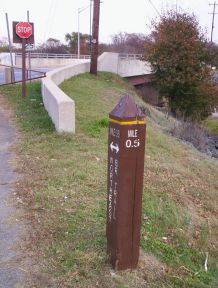 | After passing under a railroad bridge, a spur line used by freight trains, Northeast Branch Trail proceeds along a flood control berm to milepost 0.5 at Decatur St. |
| From Decatur the Northwest Branch Trail continues along the elevated berm through Riverside Drive Park. Flocks of birds often land along this stretch of trail. | 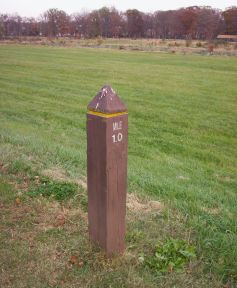 |
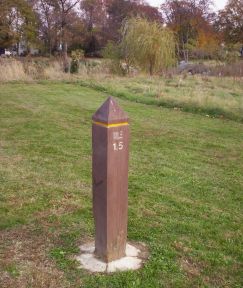 | Here the trail proceeds north-northwest past Riverdale Rd and then swerves to dive beneath East-West Hwy. It emerges to skirt the ballfields of Riverdale Recreation Area. |
| Milepost 2.0 of Northeast Branch Trail is located just south of River Road, as the path prepares to curve under yet another major street. The stream here has interesting rapids and rocky stretches. | 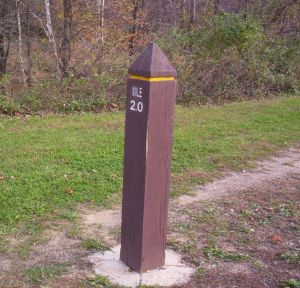 |
(Note: some coordinates of mileposts along Northeast Branch Trail have been tweaked to match Google Map imagery as of early 2008; for measured GPS coordinates --- which may contain other errors! --- see DC Metro Area Trails: GPS Waypoints; cf. RockCreekTrail (2002-05-31), AnacostiaTributaries (2003-01-28), GoogleMapExperiments (2005-09-11), RockCreekTrailMiles0To4 (2005-09-26), RockCreekTrailMiles5To9 (2006-01-16), RockCreekTrailMiles10To14 (2006-07-10), Paint Branch Trail (2008-01-12), ...)
- Thursday, February 07, 2008 at 21:06:43 (EST)
On page 8 (in the Prologue) of her autobiography Running Tide (1987, with Sally Baker) Joan Benoit Samuelson observes:
I guess I will eventually experience true success and true failure; I have not met with either yet. The only real failure is the failure to try. Perhaps one day I will find myself unwilling to try; I hope not. But should that day arrive, I will know what failure is. Similarly, it seems to me that real success comes when a person is able to say of one of her accomplishments, "That is a good job well done," and then leave that accomplishment behind. When I run a good race I think about how I might have done better and what I will do next time. True success eludes me, but I may be setting impossible standards for myself. Some day I may have to be satisfied with something less than the goals I set for myself: then and only then will I feel tested.
(cf. Joan Benoit Samuelson (2008-01-06), ...)
- Tuesday, February 05, 2008 at 20:57:27 (EST)
The "Trolley Problem" is a classic touchstone in the philosophy of ethics. (It's so much a part of the subject that it's central in a hilarious 1988 parody article, "Tissues in the Profession: Can Bad Men Make Good Brains Do Bad Things?" by Michael F. Patton, Jr. [1].) Yesterday the Sunday New York Times book section had a review by Paul Bloom of the new Experiments in Ethics by Kwame Anthony Appiah [2]. Bloom concludes with the thoughtful:
I wish every philosopher wrote like Appiah. "Experiments in Ethics" is clear and accessible (and often very funny), and Appiah is generous when it comes to discussing the work of those he disagrees with. But this book has teeth, particularly when Appiah looks hard at the emphasis on moral dilemmas like the trolley problems. These were originally developed to tap our intuitions about agency and responsibility, and are thought to bear on real-world issues like abortion and just war. But the dense trolley literature "makes the Talmud look like Cliffs Notes" even as its complexity fails, he argues, to capture the richness of morality in our everyday lives. Real moral problems don't come in the form of SAT questions, and being a good person often requires figuring out for yourself just what the options are: "In life, the challenge is not so much to figure out how best to play the game; the challenge is to figure out what game you’re playing."
This is bad news for those who hope for a simple and elegant account of moral life, which includes many of us engaged in experimental philosophy. But it fits with Appiah's worldview. Near the end of the book, he says that when he tells a stranger on a plane that he is a philosopher, he often gets the question, "So, what's your philosophy?" He answers, "My philosophy is that everything is more complicated than you thought."
(cf. WeeBitMoreComplicated (2007-08-29), ...)
- Monday, February 04, 2008 at 22:02:24 (EST)
A mound of frozen horse manure on the trail takes me by surprise half a mile into the 2008-01-26 jog along Seneca Creek. I trip over it and fall heavily to the ground, fortunately without significant damage. Caren Jew and I are trotting along the Seneca Creek Greenway Trail near Route 28 on a cool Saturday morning just after dawn. As I drive to our starting point electrical lines hang pendulous between their poles by the roadside. They glow like spiderweb threads whenever headlights from oncoming traffic on the other side of a hill illuminates them.
Further notes on that and other recent jogging adventures follow ...
2008-01-26 --- 9 miles @ 13.5 min/mi --- I get to the rendezvous parking lot (Seneca Creek and Route 28) before dawn and read a chapter of Jane Eyre while waiting. When Caren arrives we gear up and are greeted by a bowhunter getting out of his pickup truck. He's dressed in a fuzzy camo outfit that makes him look a bit like a walking mound of foliage. Today is almost the end of deer season, he tells us, and reassures us that we'll be safe in the woods. Caren points out several mallard ducks and three deer near the trail as we jog downstream. We meet two more bowhunters in their camouflage hiking the opposite way.
A huge snow-covered hillside rises in front of us and looks exactly like a distant cloud bank. Near our turnaround at Berryville Rd yet another bowhunter is parked in his truck. It features a sticker on the back that says, "Give 'em the Shaft!" We walk a few hundred yards along the road to survey the rushing waters at the usual creek crossing, then retrace our path. Our time is 55 minutes each way. We meet a friendly birdwatcher on the return trip and finish up by sprinting the last quarter mile and up the final hill to our cars. Whew!
2008-01-27 --- 10 miles @ 15 min/mi --- The VHTRC Eagle Run XVII is a fascinating ramble through the woods, with pauses to view and photograph eagles on and about the inlets of the Potomac River. I carry a heavy old 35mm manual camera (Nikon FM2) and long lens (80-200mm zoom) and shoot a roll of film, in between conversations with friends and new acquaintances. See Thirteen Eagles for a mini photo-essay about the day and http://picasaweb.google.com/zhurnaly/EagleRun2008 for all the images I came home with.
2008-01-30 --- 4+ miles @ 9 min/mi --- At the dentist today I get my teeth cleaned, which reminds me of the quote I told Caren about during a recent training jaunt (cf. RunningVersusTraining). So what to do but go on a tempo run? My daughter is recovering from some horrible disease (cold? 'flu? bronchitis?) and today my wife, my elder son, and I seem to be coming down with it. I can't find any ibuprofen ("Vitamin I") so I take two aspirin and drive my younger son Robin to the University where he has a teaching assistant session to attend. Thus I find myself at Paint Branch Trail at 1:45pm.
Today's weather is warm but winds are gusty; I two layers on top but roll up by sleeves. The trot from milepost 1.5 to 0.5 feels exhausting --- perhaps the aspirin hasn't kicked in yet? --- but flows past in 9:26, good for me. Then the 1.35 mile Lake Artemesia loop, which I take in the backwards (clockwise) direction for a change, zips by at 9:18 min/mi. Hundreds of mallard ducks float on the waters near the southwestern shore. Halfway through the circuit, at my farthest point from the start, the cellphone rings: Robin is finished early! I tell him to be patient for another 20+ minutes and to buy me a candy bar. Pushing hard I manage the return mile (0.5-1.5 markers) in a surprising 8:35. A few hours later the aspirin wears off and I come to my senses.
2008-02-02 --- 6+ miles @ 13 min/mi --- Four huge black vultures are lurking beside Colvin Run as Mary Ewell and I jog the trail toward Lake Fairfax. They lumber into the air and perch in the trees over ourheads, griping at us for disturbing their repast. Half an hour later on our return trip we encounter them again on the ground. One puffs herself up and bravely stays there as I pass within a few feet.
This Saturday morning I've got errands to run in Northern Virginia, so Mary invites me to meet her at Colvin Run Mill for a journey along one of her favorite haunts, the Fairfax Cross-Country Trail. After yesterday's heavy rains she warns of possible mud, but for the first mile it's not at all bad. Then, however, after we reach Browns Mill Rd we find the steppingstones across Difficult Run submerged by flood waters. We retrace our path to the road and follow it to the other side of the stream, only to find yet another sea blocking the FCCT. So back we turn, and near Route 7 take a side trail to Lake Fairfax Park, where we meet the vultures.
I'm in the midst of a horrible cold/cough, but it's responding to "Vitamin I" (ibuprofen!). Mary is herself recovering from an earlier illness. We do our best on the hilly path that parallels the stream but still end up taking a few walk breaks. Lake Fairfax is lovely but heavy construction is underway there. A flock of geese cruise in to land as we jog along the path near the spillway. We climb stairs and another hill above the canoe rental kiosk, then ramble back to our start with 80 minutes of good trail time.
2008-02-03 ---- 10 miles @ 10.8 min/mi --- At the end of the race early morning sunlight glisters off salt and sweat on Caren's cheeks as we catch our breath and applaud our friends Betty and Jeanne during their finishing kicks. It's a PR for Caren by a couple of minutes — not bad for somebody who's sick and who ran twice the official distance!
Comrade Caren Jew's schedule says she should do 10 miles today, and we're both coughing, so we meet at 0630 at the start/finish area of the MCRRC Country Road Run to jog the five-mile course before the 8am actual race ... and thus to prepare a perfect excuse for our anticipated slow times. Venus and Jupiter gleam low in the east, near the crescent moon. My knees are freezing and I flick my LED flashlight at oncoming cars to let them know we're out at dawn. Caren spies a herd of deer dashing across a field toward the road ahead of us. Our mile splits: 11:39 + 11:43 + 11:16 + 10:46 + 11:18 = 56:42, pretty decent we both feel.
Back at the Olney recreation center crowds have now materialized. We sign up to race and greet friends, then huddle in Caren's car to keep warm until just before the start. By my watch we cross the line 12 seconds after the official "GO!" and pound out miles at 10:05 + 10:40 + 10:22 + 9:48 + 10:02 for a total of just under 51 minutes; the race clock, however, puts us a dozen or so seconds over. No matter --- I'm obsessing over where I might have misplaced the paperwork for the relay team that I've recruited to do the George Washington's Birthday Marathon in two weeks. (I finally find the forms at home, 10 hours later, in an envelope I put them for "safekeeping".)
Ken Swab finishes many minutes ahead of Caren and me, as does Wayne Carson who is running with a couple of cracked ribs from a fall along Seneca Creek. Caren and Ken lead me to Michele McLeod's home for a lovely brunch/reception. I'm still pretty sick and leave early to avoid infecting anyone else.
(cf. PotomacHeritage50k2007 (2007-11-04), GrapevineRun (2007-11-12), DonQuixote55kRun2007 (2007-11-22), HuntingSeason (2007-11-30), FallenAngel (2007-12-08), LightningCrashes (2007-12-23), RedEye50k2008 (2008-01-05), Massanutten Mountain South Training Run (2008-01-22), Icy Half Marathon (2008-01-25), Thirteen Eagles (2008-01-28), ...)
- Sunday, February 03, 2008 at 20:38:50 (EST)
In Chapter 66 ("Prolificity") of his autobiography I. Asimov: A Memoir Isaac Asimov explains how he writes:
... I see a story or an article or a book as a pattern and not just as a succession of words. I know exactly how to fit each item in the piece into the pattern, so that it is never necessary for me to work from an outline. Even the most complicated plot, or the most intricate exposition, comes out properly, with everything in the right order.
I rather imagine that a grand master in chess sees a chess game as a pattern, rather than as a succession of moves. A good baseball manager probably sees the game as a pattern rather than as a succession of plays. Well, I see patterns too in my specialty ...
Shortly thereafter Asimov discusses the deceptive simplicity of his work:
Of course, it also helps if you don't try to be too literary in your writing. If you try to turn out a prose poem, that takes time ...
I have therefore deliberately cultivated a very plain style, even a colloquial one, which can be turned out rapidly and with which very little can go wrong. Of course, some critics, with crania that are more bone than mind, interpret this as my having "no style." If anyone thinks, however, that it is easy to write with absolute clarity and no frills, I recommend that he try it.
(cf. HowToWrite (2000-11-28), MichaelVentris (2002-07-10), IsaacAsimov (2007-11-28), ...)
- Saturday, February 02, 2008 at 14:27:58 (EST)
The lead editorial in today's New York Times, "Pakistani P.R.", begins:
You have to hand it to Pervez Musharraf. With all the problems the Pakistani president faces at home, he still found time to spend eight days in Europe last week, assuring world leaders everything is fine in his nuclear-armed state. ...
Serious stuff — but what catches my tiny literal mind is the phrase "... eight days in Europe last week ...". Does Musharraf have a time machine? Was he bilocating? Did he tunnel through a wormhole in spacetime? Whatever the mechanism, it could be more dangerous to the world than mere nuclear weapons!
- Friday, February 01, 2008 at 09:57:59 (EST)
David Cottrell's book Monday Morning Mentoring: Ten Lessons to Guide You Up the Ladder was recommended to me by a colleague interested in management and leadership issues. We both agreed that it's not terribly well-written. The dialog format seems to be modeled on the best-seller Tuesdays with Morrie, and the language is wooden. Certain bits are almost laughable, e.g., the use of the term "dehire" for the act of firing a bad employee.
But Cottrell does make some good points — especially in the final chapter, "The Gift of Your Legacy". He tells the parable (which I first heard from a Boy Scout leader a decade ago) about two men who separately ask an old-timer what the people are like in a town that they're moving to. "What were the people like in the town you came from?" the codger asks. One says that they were mean and unfriendly. "Sounds about like the people who live here," is the reply. The other says that he came from a town of wonderful, helpful citizens. "Sounds about like the people who live here," is again the response.
There's a good dose of classical Stoic philosophy:
... Your attitude is completely internally controlled ... a personal response to conditions and circumstances ... no one can externally control your own attitude. ... all things that happen to us are not all within our control, but we do control how we respond to those events. We choose how we react ... no one can make that choice for us. ...
And in discussing what really counts, Cottrell quotes George Washington Carver:
How far you go in life depends on you being tender with the young, compassionate with the aged, sympathetic with the striving, and tolerant of the weak and the strong. Because someday in life you will have been all of these.
(cf. BennettOnStoicism (1999-04-29), BeyondTheInnerCitadel (1999-09-26), InsideTheInnerCitadel (2002-10-15), StoicStruggles (2002-12-22), ...)
- Wednesday, January 30, 2008 at 15:54:04 (EST)
| The Virginia Happy Trails Running Club [1] annually holds a free "Eagle Run" on the last Sunday in January. This year's was the 17th. The event begins and ends at veteran ultrarunner Gary Knipling's house and proceeds through the woods of the Mason Neck, a peninsula in northern Virginia on the Potomac River about ten miles south of Washington DC. A mile or so into our trek we pause to admire eight eagles sitting on the ice of Belmont Bay. | 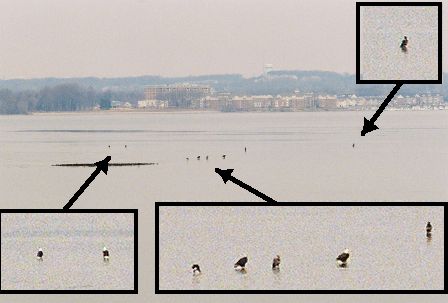 |
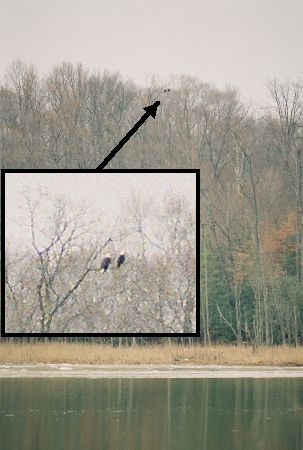 | From the same promontory we spy two more eagles perched in a tree across an inlet of Belmont Bay. The faster runners (or those less interested in birds) proceed while I snap photographs with an old Nikon FM2 manual 35mm camera and a similarly antique 80-200mm zoom lens. It's heavy to carry, and the Kodak 800 film I'm using has significant grain, but at maximum zoom the eagles are distinctly visible. |
| A few friendly stragglers lead me along a winding trail through the woods to an overlook where we see another eagle across the water, probably in or near Mason Neck State Park. The forest floor is covered with a thick blanket of fallen leaves, so tree roots are a distinct hazard as we jog back to Gary's home and along Harley Rd to the first aid station. | 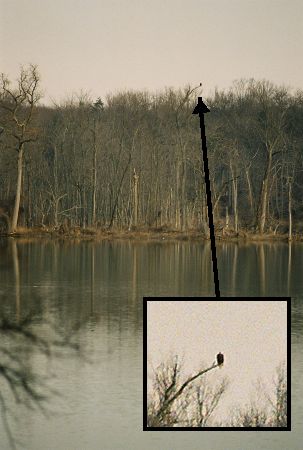 |
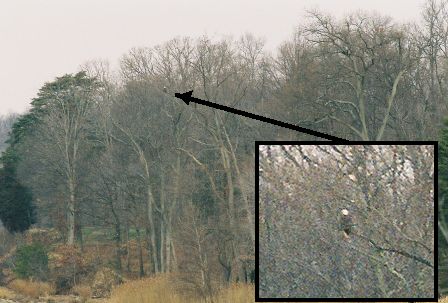 | After refueling on nuts and soda I join some runners who have taken a longer route. We ramble through a horse farm and across Gunston Rd to Pohick Bay Regional Park. Here those who want more mileage and more eagles follow signs to "Long" or "Medium" routes. I join Rick, a Ph.D. biochemist and patent examiner who is suffering from ITB pain and whose pace is compatible with mine. Rick lives in the area and shows me the way to Pohick Bay where we see another eagle in a tree across the water. |
| A strange barking sound gives me pause as Rick and I jog along the waterfront. Its source? Waves from Pohick Bay are striking the sheet of ice on the southern shore and breaking it up as temperatures rise. Rick and I catch up with other runners who point out an eagle perched not far from us in a tree on our side of the bay. It's our closest encounter with the species, and the last sighting of the day except for some distant glimpses of soaring immature eagles later on. | 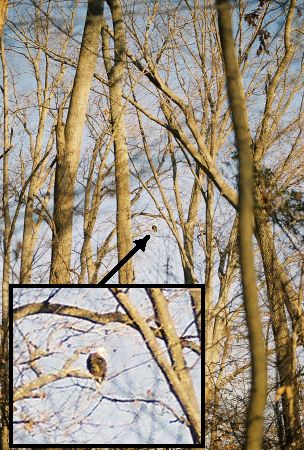 |
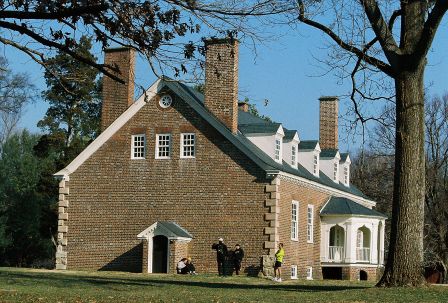 | We enter historic Gunston Hall Plantation — the home of George Mason, one of the Founding Fathers of the US and a primary architect of the Bill of Rights. Runners who arrive early wait on the sunny side of Mason's home, Gunston Hall, built 1755-1760. When those who have gone farther arrive we gather and hear a brief talk on the history of the Plantation, focusing on African American slave communities in the area. Then we eat some pizza. Dedicated runners continue onward; others, like me, jog back to the starting point. |
See http://picasaweb.google.com/zhurnaly/EagleRun2008 for 23 photos I took of Eagle Run XVII. Many thanks to Gary Knipling and the VHTRC for sponsoring a unique experience!
- Monday, January 28, 2008 at 21:36:03 (EST)
The (in)famous "Schrödinger's Cat" thought-experiment highlights an (apparent) paradox of quantum mechanics. A cat is placed in a box, and an apparatus containing an unstable atomic nucleus is connected to machinery that will kill the cat if the nucleus decays. If nobody is observing the cat, is it alive, or dead, or in some nonclassical superposition of quantum states? Weighty tomes have been written about the question.
But equally important, and not yet discussed in the physics literature, are the following found in a lost notebook of Erwin Schrödinger that I purchased recently via Internet auction (so it must be genuine):
Other pages discuss Schrödinger's Cataracts, Schrödinger's Caterpillar, Schrödinger's Cathode, Schrödinger's Cattle, etc. Unfortunately the notebook itself is almost impossible to understand; whenever I try to look at a page, the letters swim about and rearrange themselves faster and faster the harder I work to read them ...
(with apologies to Mark Twain's "A Cat Tale"; cf. QuantumNondemolition (2000-02-05), NoConceptsAtAll (2001-02-22), CorrespondencePrinciple (2003-03-04), ManyWorlds (2006-08-17), ...)
- Saturday, January 26, 2008 at 14:48:23 (EST)
After yesterday's Arctic chills this morning feels almost warm, with temperatures in the low 20's. Christina Caravoulias and I meet just after 7am in the downtown Bethesda parking lot. I leave my car and ride with her to the Rockville Metro, chugging electrolyte drink to avoid dehydration. I anticipate frozen water fountains; fortunately I'm wrong. The main fountains every few miles are indeed frozen solid, but the taps on the side that supply "dog water" work fine, so I refill my bottle and Chris takes off a glove to catch water in her cupped hand --- brrrrr!
Further notes on that (2008-01-21) and other recent runs follow ...
2008-01-12 --- 5 miles @ 14 min/mi & 6 miles @ 10 min/mi --- A red fox dashes away as Mary Ewell and Kevin Lee and I trot along what might be part of the Potomac Heritage Trail upstream of Riverbend Regional Park. Our path follows the Virginia shore of the Potomac just above Great Falls, gentle terrain except where it climbs over steep ridges, smooth except where tree roots hide under the blanket of fallen leaves. Half a mile into the run we reach the hill which Mary and I ran up on 2007-09-29 near the end of a long jog (see MatherGorge). That time I issued the challenge; today Mary throws down the gauntlet. She does half a dozen repeats; Kevin is similarly strong, but I only survive half as many. More hill work needed!
After recovering we continue upstream for a few more miles until the trail leads mysteriously away from the river to a decrepit wildlife sanctuary hut. Nearby is an ancient-looking stone springhouse. We circle the building (almost falling into a pit concealed by leaves) and return. Merle is awaiting us; he has been exploring and photographing the Riverbend Park shoreline and nearby forests.
Saturday afternoon I take Gray to the University of Maryland and discover the gates to Kehoe Track chained and locked against me. No speedwork there! So I jog across campus to Paint Branch Trail and trot briskly from milepost 1.5 to 3.5 and back. The weather is cool and I encounter enough spectators to keep me moving briskly, with mile splits of 9:34 + 9:29 + 9:08 + 8:46 (whooo!). The journey to/from the parking lot near the music building takes 11 minutes each way.
2008-01-19 --- 5 miles @ 8.4 min/mi --- In contrast to previous years of single-digit or low-teens temps, it's a positively balmy near-freezing at this morning's '''Shooting Starr''' MCRRC five miler. Jeanne Larrison is volunteering at the registration table and kindly gives me #333 again this year: the Half Beast is Back! Christina Caravoulias is there before me and signs up to run the George Washington's Birthday Marathon Relay that I've printed out the paperwork for; Betty Smith follows suit. Now we only need one more to fill out a Women Masters team! Last year there were three awards but only one team in that category, so it seems like a good bet to try. I'm hoping to run the GWBM marathon myself, perhaps with some of the relay participants. It will be my fifth year in a row for that race.
When the building opens I go in and find Ken Swab, back from work-related travels and about to fly out again. We chat about our families and I express my condolences over his father's recent death. Home construction work is an ongoing ordeal for us both. I try to massage some warmth into my frozen feet. (I ask Ken to help rub them, but even though his employer is into serving the customer he respectfully declines.) The race start is delayed for 15 minutes so we stay inside as long as possible, then emerge to stand near the back of the pack with Christina, Betty, Jeanne, and several other comrades. Chris tells me to go ahead and not run with her. She's in the speed development program and wants to do her own race today. We plan to take a longer run together on Monday, a holiday for us both. Beth Starr, widow of Jim Starr whom this race honors, talks briefly and then we're off.
I commence briskly, hoping to be able to maintain sub-9 minutes/mile as per my recent training jogs. The course, slightly modified from past years, runs through an aptly named Hillandale neighborhood and features multiple long inclines. Ken drops back but catches me near the 1 km area. He reminds me to extend my stride and accelerate downhill. I follow that advice as well as Christina's guidance to attack uphill segments with strong arm motion. It seems to help. After about 3.5 miles my legs start to feel weak, but I keep pushing when I see that I'm on pace for a sub-45-minute time. My splits: 8:23 + 8:05 + 8:21 + 8:41 + 8:19 with an official finish time of 41:51. I'm in 131st place overall, a startling 8 of 16 in my new 55-59 male age group. Whee! It looks like a PR, compared to past results at this race on similar courses: 2007 = 56:31, 2006 = 46:40, 2005 = 53:31, 2004 = 53:21 ...
2008-01-20 --- 11+ miles @ 22+ min/mi --- see Massanutten Mountain South Training Run ...
2008-01-21 --- 13+ miles @ 16 min/mi --- Christina and I walk to the official Parks Half Marathon starting line near the Rockville Metro station, then jog most of the first two miles down Veirs Mill Rd. Ice on shaded slopes is a sporadic problem, especially once we join Rock Creek Trail for miles 3-10. We walk cautiously through dangerous patches and manage to avoid falling down. As the sun rises so does the temperature, towards the upper 20's.
Wildlife is absent except for a few crows and a frozen squirrel that Chris spots and that I thankfully miss. Leaves at the bottom of a puddle, trapped under a glass-clear layer of ice that reflects the sky, bring to mind the M. C. Escher print "Three Worlds". Dog-walkers bundled up in parkas and scarves look with amazement at our skimpy outfits. (Both Christina and I make a limited concession to the cold and wear tights, unusual for us.) Our walk breaks help us both feel relatively comfortable throughout the journey. In Bethesda Chris picks up a hot apple cider to drink and I drive us back up the Pike to drop her off at her car.
(cf. Jfk2007Preparation (2007-10-26), PotomacHeritage50k2007 (2007-11-04), GrapevineRun (2007-11-12), DonQuixote55kRun2007 (2007-11-22), HuntingSeason (2007-11-30), FallenAngel (2007-12-08), LightningCrashes (2007-12-23), RedEye50k2008 (2008-01-05), Massanutten Mountain South Training Run (2008-01-22), ...)
- Friday, January 25, 2008 at 18:15:08 (EST)
Some "business" books are well-meaning but, alas, overreach into unconscious parody or silliness. Others are just a bit too relentless in self-promotion. At the office during the past few decades I've seen the pursuit of excellence, the search for total quality management, the quest to achieve sustained high performance, and more. I've taken Myers-Briggs tests to discover that I'm an Introverted, Intuitive, Thinking, Perceiving person.
Most recently members of my work group all were given copies of a book with the unwieldy name Now, Discover Your Strengths: The Revolutionary Program That Shows You How to Develop Your Unique Talents and Strengths --- and Those of the People You Manage. (My An Lab study many years ago suggested that quality somehow tends to be inversely related to title length, but ignore that for now!) With the book came an online multiple-choice test that told me my five greatest strengths were:
Let's not criticize the unæsthetic lack of parallelism in those Rohrschach ink-blot categories. How true are they? Not too bad ... though my Chinese zodiac animal, the Dragon, has as good a list of positive traits. Dragons are, among other sometimes-contradictory things: noble, ambitious, dignified, charismatic, magnanimous, confident, good-hearted, forgiving, active, nice, fun, straight-forward, happy, spontaneous, protective, versatile, eloquent, social, assertive, dramatic, independent, and freedom-loving. Hey, that's me!
cf. Director of Optimal Performance - ^z - 2008-01-24
- Thursday, January 24, 2008 at 05:25:42 (EST)
On New Year's Day during the Red Eye 50k I trip on a rock and collapse forward, landing flat with a thump! This Sunday, descending the steep Massanutten Mountain Waterfall Trail I slip on the leaves and with another loud thump! find myself suddenly flat on my back. My pair of stumbles, fore and aft, brings to mind the Nurse's bawdy lines in Act I Scene iii of Romeo and Juliet describing events from Juliet's infancy. As a toddler Juliet takes a tumble and gets a goose egg on her forehead. The Nurse's husband comforts the baby: "... dost thou fall upon thy face? Thou wilt fall backward when thou hast more wit ..."
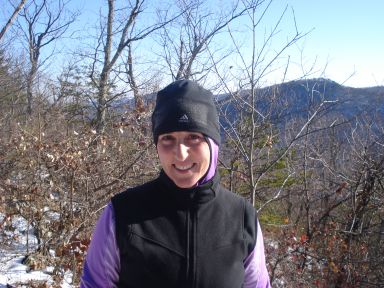 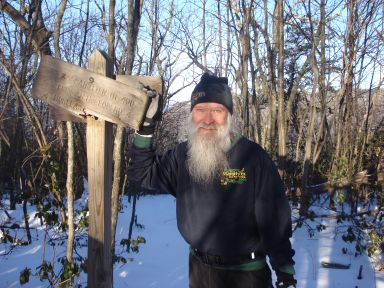 | 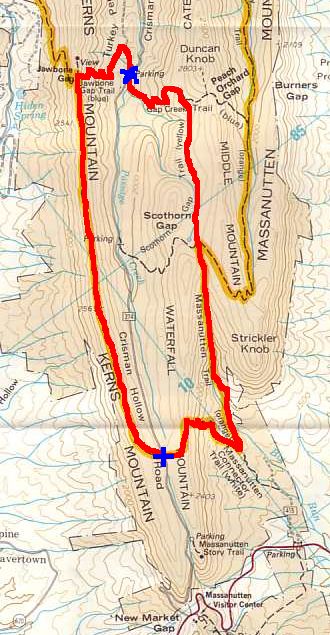 |
2008-01-20 --- 11+ miles @ 22+ min/mi --- The red line shows our counter-clockwise route: Caren Jew and I begin the expedition at the blue "X" at the top of the map and climb 500 feet to the ridge on the west that forms Kerns Mountain. Then we go south along the Massanutten Trail and descend back to Crisman Hollow Rd at the blue "+" where Quatro Hubbard's aid station helps us refuel. (Quatro tells me that he has looked at my DC Boundary Stone web pages, as part of his work as Archivist for the Virginia Department of Historic Resources. One meets fans in the strangest places!) We descend steeply another 500 feet on the old Waterfall Mountain segment of the Massanutten Trail, turn north, then climb back to our starting point via Scothorn Gap Trail and Gap Creek Trail.
How did we get here, trekking across snow and rocks with temperatures in the teens? As usual, Caren swindles me into it! I get up at 3am and meet her a bit after 5 at the Davis Library. She drives the two-plus hours to the southern end of Massanutten Mountain where today's G2G = "Gap to Gap" VHTRC training run is scheduled to begin. Along the way we listen to a CD I've made of running songs and bob our heads to the beat of ZZ Top, David Bowie, Blues Traveler, and other classic rock. A yellow-tinged gibbous moon sets in the west; Venus rises over the mountains to our the east. At the McDonalds just off I-81 in New Market we pause to visit the facilities and discover more than half a dozen other trail runners similarly preparing for a frigid winter morning.
Caren's notes capture the spirit of the day:
I must observe that Caren herself:
My diagnosis of the problems that we both experience today: dehydration brought on by exertion in the cold dry air. When I get home I weigh myself and find that I've lost more than half a pound compared to this morning --- and that's after our stop at a fast food restaurant on the way back where I inhale veggie burger, fries, and soda water. Actual dehydration was thus probably over 2 lbs. for me.
Overall the Massanutten experience is an excellent one: daunting hills and bitter cold add to the terrain's beauty. Crows scold us for intruding on their turf. Icicles grow on my moustache and beard as our water bottles freeze. And we survive!
(Huge thanks to Quatro Hubbard and Mike Burr of the VHTRC for organizing and supporting this fun run; special thanks to Caren Jew for inviting me to do it with her! Photos by Caren Jew. Map clipping courtesy Potomac Appalachian Trail Club, annotations by ^z. Cf. Jfk2007Preparation (2007-10-26), PotomacHeritage50k2007 (2007-11-04), GrapevineRun (2007-11-12), DonQuixote55kRun2007 (2007-11-22), HuntingSeason (2007-11-30), FallenAngel (2007-12-08), LightningCrashes (2007-12-23), RedEye50k2008 (2008-01-05), ...)
- Tuesday, January 22, 2008 at 21:39:02 (EST)
Stephen Crane's 1895 novel The Red Badge of Courage offers rather a rambling plot line — perhaps like war itself — accompanied by striking language and metaphor. For example, when battle looms near the beginning of Chapter V:
There was rustling and muttering among the men. They displayed a feverish desire to have every possible cartridge ready to their hands. The boxes were pulled around into various positions, and adjusted with great care. It was as if seven hundred new bonnets were being tried on.
In tone and style Red Badge frequently resembles Leo Tolstoy's War and Peace, e.g. when Crane's Chapter XIX depicts a pointless charge into the teeth of enemy fire:
It seemed to the youth that he saw everything. Each blade of the green grass was bold and clear. He thought that he was aware of every change in the thin, transparent vapor that floated idly in sheets. The brown or gray trunks of the trees showed each roughness of their surfaces. And the men of the regiment, with their staring eyes and sweating faces, running madly, or falling, as if thrown headlong, into queer, heaped-up corpses — all were comprehended. His mind took a mechanical but firm impression, so that afterwards everything was pictured and explained to him, save why he himself was there.
Shades of Prince Bolkonsky and Pierre Bezhukov!
cf. InfiniteSky (2004-10-15), ...
- Monday, January 21, 2008 at 05:24:13 (EST)
In Chapter 30 of his autobiography I. Asimov: A Memoir Isaac Asimov tells of "... one of my more incredible mistakes ..." — the decision to major in zoology in graduate school:
... Oh, I would have done well enough if it were a mere matter of book learning, but it wasn't. There was a laboratory and we dissected earthworms, frogs, dogfish, and cats. I disliked it intensely but I grew inured to it.
The trouble was that we had to find a stray cat and kill it by dumping it in an ashcan which we filled with chloroform. Like a fool, I did it. After all, I was only following the orders of my superior, like any Nazi functionary in the death camps. But I never recovered. That killed cat lives with me, and to this day, over half a century later, when I think of it, I double up in misery.
I dropped zoology at the completion of the year.
This, incidentally, is an example of the division between intellectual and emotional understanding. Intellectually, I understand the necessity for animal experimentation if medicine is to be advanced (provided the experimentation is absolutely necessary and is carried through with a minimum of suffering). I can argue the point eloquently.
However, I will never, under any circumstances, participate in such experimentation or even observe it. When the animals are brought in, I always leave.
(cf. SufferTheAnimals (2000-06-11), CompassionateCarnivorism (2002-11-19), IsaacAsimov (2007-11-28), ...)
- Sunday, January 20, 2008 at 03:21:43 (EST)
For back issues of the ^zhurnal see Volumes v.01 (April-May 1999), v.02 (May-July 1999), v.03 (July-September 1999), v.04 (September-November 1999), v.05 (November 1999 - January 2000), v.06 (January-March 2000), v.07 (March-May 2000), v.08 (May-June 2000), v.09 (June-July 2000), v.10 (August-October 2000), v.11 (October-December 2000), v.12 (December 2000 - February 2001), v.13 (February-April 2001), v.14 (April-June 2001), 0.15 (June-August 2001), 0.16 (August-September 2001), 0.17 (September-November 2001), 0.18 (November-December 2001), 0.19 (December 2001 - February 2002), 0.20 (February-April 2002), 0.21 (April-May 2002), 0.22 (May-July 2002), 0.23 (July-September 2002), 0.24 (September-October 2002), 0.25 (October-November 2002), 0.26 (November 2002 - January 2003), 0.27 (January-February 2003), 0.28 (February-April 2003), 0.29 (April-June 2003), 0.30 (June-July 2003), 0.31 (July-September 2003), 0.32 (September-October 2003), 0.33 (October-November 2003), 0.34 (November 2003 - January 2004), 0.35 (January-February 2004), 0.36 (February-March 2004), 0.37 (March-April 2004), 0.38 (April-June 2004), 0.39 (June-July 2004), 0.40 (July-August 2004), 0.41 (August-September 2004), 0.42 (September-November 2004), 0.43 (November-December 2004), 0.44 (December 2004 - February 2005), 0.45 (February-March 2005), 0.46 (March-May 2005), 0.47 (May-June 2005), 0.48 (June-August 2005), 0.49 (August-September 2005), 0.50 (September-November 2005), 0.51 (November 2005 - January 2006), 0.52 (January-February 2006), 0.53 (February-April 2006), 0.54 (April-June 2006), 0.55 (June-July 2006), 0.56 (July-September 2006), 0.57 (September-November 2006), 0.58 (November-December 2006), 0.59 (December 2006 - February 2007), 0.60 (February-May 2007), 0.61 (April-May 2007), 0.62 (May-July 2007), 0.63 (July-September 2007), 0.64 (September-November 2007), 0.65 (November 2007 - January 2008), 0.66 (January-March 2008), 0.67 (March-April 2008), 0.68 (April-June 2008), 0.69 (July-August 2008), 0.70 (August-September 2008), 0.71 (September-October 2008), 0.72 (October-November 2008), ... Current Volume. Send comments and suggestions to z (at) his.com. Thank you! (Copyright © 1999-2008 by Mark Zimmermann.)